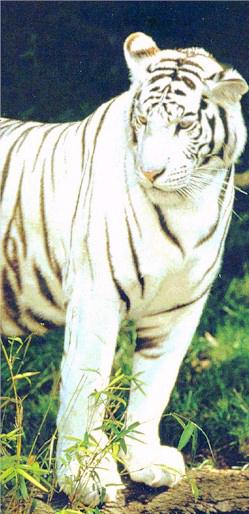|
What They Say At:
http://www.5tigers.org/white.htm
White tigers
White tigers are just white-colored Bengal tigers, they are not a separate subspecies of tiger, and they are not albinos. They have blue eyes, a pink nose, and creamy white fur with chocolate colored stripes. White tigers are only born when two tigers that both carry the unusual gene for white coloring mate. Wild white tigers are very rare, and today they can only be seen in zoos.
- White Tigers
- by Ronald L. Tilson
- Coordinator, CBSG Tiger Global Conservation Strategy (GCS)
The following excerpts originally appeared as a Commentary in Zoo Biology
(11:71-73, 1992).
- Tigers are an Asian species, found from the frozen tundra of the Soviet Far East, south
to the humid jungles of Malaya and Indonesia, and west to the hot, hardwood forests of
India. There are five living subspecies; three others are already extinct. Current
estimates put the world population of wild tigers at about 5,000-7,000, the most numerous
race being the Bengal race, distributed among some 18 tiger reserves and sanctuaries of
India (and a half-dozen in Nepal and Bangladesh), accounting for over two-thirds of all
wild tigers.
- �
- Every once in a great while, a white tiger appears in the wild. White tigers differ from
ordinary orange tigers (if a tiger can be referred to as ordinary) in having ice-blue
eyes, a pink nose, and creamy white fur with chocolate stripes. White tigers are not
albinos; their color is caused by a double recessive allele. A Bengal tiger with two
normal alleles or one normal and one white allele is colored orange. Only a double dose of
the mutant allele results in white tigers.
- �
- How frequently do white tigers appear in nature? No one knows. But we do know that in
the last 100 years, only about a dozen such white tigers have been seen in India (white
forms have never been reported for any of the other subspecies). During this same century,
the Bengal tiger population has dropped from 40,000 to a low of 1,800 tigers, and
approximately 100,000 have lived and died, suggesting that as few as one in every 10,000
tigers is white.
- �
- The white tiger collection in North American zoos traces its ancestry to a single white
male known as Mohan, captured in 1951 in central India. It did not take long for the
Maharajah who captured him to figure out that the only way to produce additional white
tiger cubs was to breed Mohan back to his daughter, who gave birth to the first generation
of captive-born white tigers in this century. One of these granddaughters, Mohini, was
bred with her uncle and half-brother, an orange male called Sampson. It was through Mohini
that the white tiger line came to the United States through the National Zoo in Washington
D.C., From there, two of Mohini's offspring, a brother and sister, were bred at the
Cincinnati Zoo and their daughter, Kesari, founded the Cincinnati white tiger line.
- �
- In Cincinnati, the inbreeding continued. Bhim, a white son of Kesari, was mated to his
sisters Kamala and Sumita, and so on. Altogether, the average inbreeding coefficeint of
the white tiger lineages is much higher that that of either Sumatran of Siberian tigers
managed by the tiger SSP which is methodically working towards minimizing the average
inbreeding coefficient of its captive population. This translates into a healthier
population and decreases the probability of a number of reproductive and disease problems
associated with inbreeding.
- �
- An SSP is a breeding strategy followed by participating zoos that is designed to
maintain small self-sustaining populations of endangered species in captivity. Every
breeding recommendation is designed to minimize the average inbreeding coeffcient of the
population and to equalize the genetic representation of each wild-caught animal
("founders" of the captive population). With some 63 such species blueprints in
hand, zoos are increasingly becoming last-ditch refuges for endangered species, as a kind
of biological (rather than biblical) Noah's ark. Already on board are several species now
extinct in the wild that survive only in zoos, including Pere David's deer and Asian wild
horses, and three additional species, the California condor, Arabian oryx, and
black-footed ferret, are currently making their way back into the wild thanks to captive
breeding.
- �
- The white tiger controversy among zoos is a small part ethics and a large part
economics. For example, the tiger SSP has condemned breeding white tigers because of their
mixed ancestry (most have been hybridized with other subspecies or are of unknown lineage)
and because they serve no conservation purpose. Owners of white tigers say white tigers
are popular exhibit animals and help increase zoo attendance and, at $60,000 each,
revenues as well. The same story can be applied to the selective propagation of melanistic
leopards, white lions, king cheetahs, and other phenotypic aberrations.
- �
- However, there is an unspoken issue that shames the very integrity of zoos, their
conservation programs, and their message to the visiting public. To produce white tigers
or any other phenotypic curiosity, directors of zoos and facilities must continuously
inbreed, father to daughter, to granddaughter, and so on. At issue is a contradiction of
fundamental genetic principles upon which all SSPs for endangered species in captivity are
based. White tigers are an aberration artificially bred and proliferated by a few zoos,
private breeders, and circus folks, who do this for economic rather than conservation
reasons.
|




 MANY PEOPLE HAVE MISCONCEPTIONS ON WHAT A WHITE TIGER IS... A WHITE TIGER IS NOT A NEW SPECIES OF TIGER AT ALL, OR A SUBSPECIES THAT LIVES UP IN NORTHERN ASIA
MANY PEOPLE HAVE MISCONCEPTIONS ON WHAT A WHITE TIGER IS... A WHITE TIGER IS NOT A NEW SPECIES OF TIGER AT ALL, OR A SUBSPECIES THAT LIVES UP IN NORTHERN ASIA  TO BLEND IN WITH THE SNOW, BUT REALY, A MUTANT. A WHITE TIGER IS BORN BECAUSE OF A RARE MUTATED GENE THAT ONE OR BOTH PARENTS MAY HAVE INHERITED FROM THEIR PARENTS. IN ZOOS, THIS GENE IS ENCOURAGED BY BREADING. BUT NOT ALL WHITE TIGERS WILL HAVE WHITE OFFSPRING.
TO BLEND IN WITH THE SNOW, BUT REALY, A MUTANT. A WHITE TIGER IS BORN BECAUSE OF A RARE MUTATED GENE THAT ONE OR BOTH PARENTS MAY HAVE INHERITED FROM THEIR PARENTS. IN ZOOS, THIS GENE IS ENCOURAGED BY BREADING. BUT NOT ALL WHITE TIGERS WILL HAVE WHITE OFFSPRING.